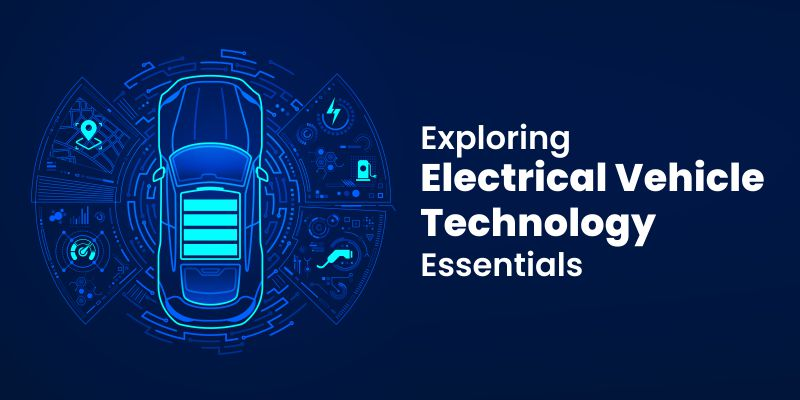30 Jan

|
Getting your Trinity Audio player ready...
|
In the dynamic realm of modern transportation, a revolutionary evolution is unfolding, the widespread adoption of electric vehicles (EVs). As the automotive landscape undergoes a paradigm shift driven by environmental consciousness, technological advancements, and shifting consumer preferences, understanding the essentials of electric vehicle technology becomes paramount.
In this blog, we embark on a journey to explore the key facets of EV technology, from the core components of electric vehicles to the driving forces behind their rise.
Whether you’re an automotive enthusiast, a professional in the industry, or someone considering a career transition, gaining insights into EV technology through comprehensive EV training becomes a strategic move. This exploration not only equips individuals with the knowledge needed to navigate the transformative changes in the automotive sector but also positions them at the forefront of the evolving landscape.
Table of Contents
Core Components of Electric Vehicles:
Battery Technology
The significance of battery technology in electric vehicles cannot be overstated. At the core of every electric vehicle lies a sophisticated energy storage system—the battery. Advances in battery technology, especially the widespread adoption of lithium-ion batteries, have been pivotal in propelling the rise of electric vehicles. These batteries function as the powerhouse of the vehicle, storing electrical energy and supplying it to the electric motor when needed. The evolution of battery technology directly influences crucial factors such as the vehicle’s range, charging speed, and overall performance.
Lithium-ion batteries, with their high energy density and relatively lightweight construction, have emerged as the preferred choice for electric vehicles. Ongoing research and development in battery technology aim to enhance energy storage capacity, reduce charging times, and improve the overall longevity of batteries. Understanding the intricacies of battery technology is essential for engineers, manufacturers, and researchers striving to push the boundaries of electric vehicle capabilities.
Electric Motors and Drivetrains
Electric vehicles usher in a paradigm shift by replacing traditional internal combustion engines with electric motors. The electric drivetrain is a comprehensive system that includes the electric motor, power electronics, and transmission. This configuration marks a departure from the complex mechanical components of traditional vehicles, offering a simpler and more efficient approach to propulsion.
The electric motor serves as the primary source of propulsion, generating instantaneous torque for a responsive and smooth driving experience. Unlike internal combustion engines, electric motors operate with fewer moving parts, leading to reduced maintenance requirements and improved reliability. Power electronics control the flow of electrical energy between the battery and the motor, ensuring optimal efficiency and performance. The transmission, though simpler than traditional counterparts, plays a crucial role in optimizing torque delivery to the wheels.
Understanding the nuances of electric motors and drivetrains is essential for engineers and technicians involved in the design, manufacturing, and maintenance of electric vehicles. Mastery of these components is key to unlocking the full potential of electric propulsion systems.
Charging Infrastructure
The development and deployment of a robust charging infrastructure are fundamental to the widespread acceptance of electric vehicles. The charging infrastructure encompasses a network of charging stations designed to replenish the energy stored in electric vehicle batteries. Understanding the intricacies of charging infrastructure is crucial for stakeholders ranging from manufacturers to end-users.
Charging stations come in various forms, including standard home chargers, public charging stations, and fast-charging networks. Standard home chargers are typically used for overnight charging, providing a convenient option for residential EV owners. Public charging stations, strategically located in urban areas and along highways, cater to the on-the-go charging needs of electric vehicle users. Fast-charging networks utilize high-powered chargers to significantly reduce charging times, addressing the range anxiety often associated with electric vehicles.
For manufacturers, designing vehicles compatible with different charging standards and ensuring interoperability with diverse charging networks is a strategic consideration. Consumers benefit from understanding the types of chargers available and their compatibility with their electric vehicles, optimizing the charging experience. As the charging infrastructure continues to evolve, collaboration among stakeholders is essential to create a seamless and accessible charging ecosystem, further propelling the adoption of electric vehicles.
Technological Advancements
-
Battery Management Systems (BMS)
Battery Management Systems monitor and control various aspects of the battery, ensuring optimal performance, longevity, and safety. Understanding BMS technology is crucial for maximizing the efficiency and reliability of electric vehicle batteries.
-
Regenerative Braking
Electric vehicles often feature regenerative braking systems that convert kinetic energy into electrical energy during deceleration. This technology improves energy efficiency and extends the vehicle’s range. Exploring how regenerative braking works provides insights into enhancing overall EV performance.
-
Vehicle-to-Grid (V2G) Technology
V2G technology enables bidirectional energy flow between electric vehicles and the electric grid. This innovation allows EVs to not only consume energy but also contribute excess energy back to the grid, potentially transforming them into mobile energy storage units. Understanding V2G technology is key to unlocking its potential benefits.
Environmental Impact and Sustainability
-
Reduced Greenhouse Gas Emissions
Electric vehicles contribute to a reduction in greenhouse gas emissions compared to their internal combustion counterparts, especially when charged with renewable energy sources. Exploring the environmental benefits of EVs is integral to understanding their role in mitigating climate change.
-
Life Cycle Analysis
Assessing the environmental impact of electric vehicles involves considering their entire life cycle, from manufacturing to end-of-life disposal. Exploring life cycle analysis provides a comprehensive understanding of the overall sustainability of electric vehicles.
Future Trends and Innovations
-
Autonomous Electric Vehicles:
The integration of autonomous driving technology with electric vehicles is a future trend that holds immense potential. Understanding the intersection of autonomy and electrification is crucial for staying ahead in the evolving landscape of smart and sustainable transportation.
-
Solid-State Batteries:
Solid-state batteries represent the next frontier in battery technology. These advanced batteries promise higher energy density, faster charging times, and enhanced safety. Exploring the potential of solid-state batteries is key to anticipating future advancements in electric vehicle technology.
Conclusion
As electric vehicles reshape the automotive landscape, delving into the essentials of electric vehicle technology is not only insightful but also essential for professionals, enthusiasts, and anyone intrigued by the future of transportation. The journey into the core components, technological advancements, environmental impact, and future trends of electric vehicles unveils a world of innovation, sustainability, and transformative possibilities.
Whether you are an engineer, a policymaker, or a consumer, understanding these essentials positions you at the forefront of the electric vehicle revolution, contributing to a cleaner, greener, and technologically advanced future.


